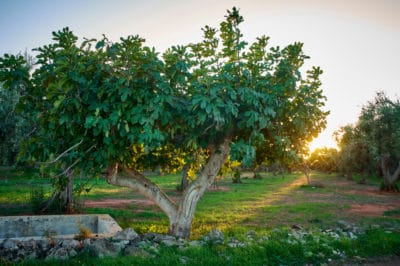Choosing A Variety
You can choose from dozens of fig varieties. These are widely available:
- Excel – yellow fruit, hardy and self-fruitful.
- Brown Turkey – mahogany to purple, heavy crops.
- Black Mission – purple-black, long-lived and heavy bearing commercial standard.
- Ischia – greenish-yellow fruit, semi-dwarf, less attractive to birds.
- Kadota – light-skinned, vigorous, must have hot weather to ripen.
- Osborne – purplish-brown, favorite for coastal areas.
Climate for Fig Trees
The fig’s native habitat is the Mediterranean area. Gardeners in USDA Zones 9 to 11 often have similar climates and can grow most figs. Zone 12 can be too hot for good fruit production. Fig trees differ in hardiness depending on the variety, but some are hardy to Zone 5 or 6. They will die back to the ground in colder areas, but the roots may survive.
Soil for Figs
Like any fruit tree, figs will grow better in fertile soil. However, very rich soil results in extensive canopy growth rather than fruit production. The plant prefers a pH between 6.0 and 6.5, but will tolerate acid soils. Good drainage is a must. If your soil is heavy clay, amend it with a little humus and lots of coarse builder’s sand before planting figs.
Watering Figs
Although fig trees are naturally drought tolerant, they will grow and produce better with adequate water. Soak fig trees in the garden about once a week. You may need to water more frequently when weather is hot and windy. Water fig trees in containers when the top inch of soil is dry. Allow to drain completely. Don’t over-water – it can cause root rot.
Fig Tree Pests
Birds are the biggest problem for most gardeners who grow fig trees. The fruit must ripen on the tree and is thin-skinned. Prune the trees to about 10 to 12 feet and use netting. Light-colored varieties seem to be less attractive to birds. Fig tree borer is the most serious insect pest. Wrap the lower trunk with shade netting banded top and bottom with foil rubbed with Vaseline to prevent egg-laying.
Diseases and Fig Trees
Over-watering is the most likely reason for figs to develop diseases. Anthracnose and fig rust can be treated with fungicides. Endosepsis and aspergillosis are also fungal diseases, but much more serious. The tree should be destroyed and the ground treated with fungicides. Fig mosaic is a viral disease; control by spraying horticultural oil.
